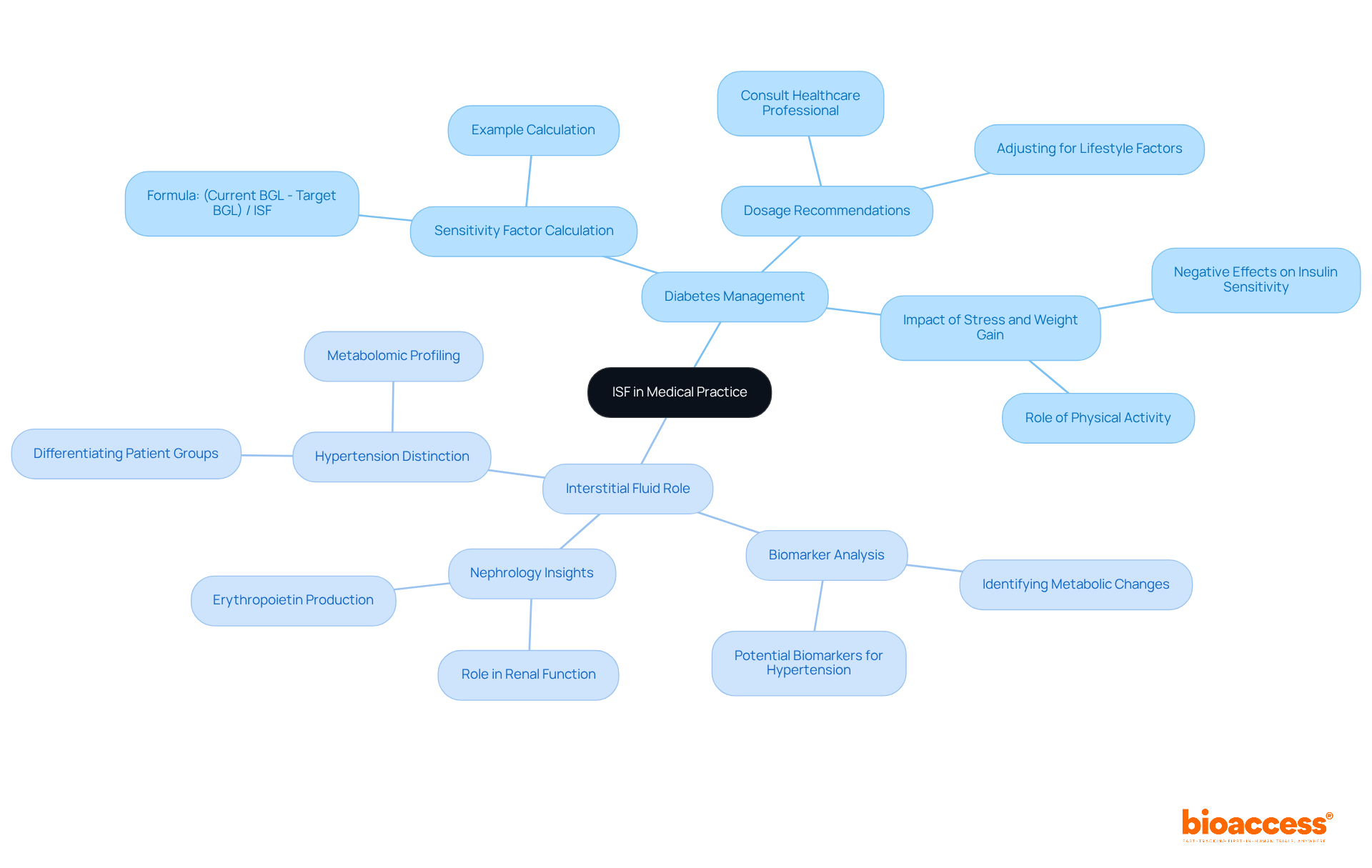


Understanding medical abbreviations is crucial for navigating the complexities of healthcare, especially in managing conditions like diabetes. The ISF abbreviation, which stands for both Insulin Sensitivity Factor and Interstitial Fluid, significantly influences treatment strategies and enhances patient outcomes. This duality raises important questions about its implications in clinical practice and the need for personalized treatment approaches.
What challenges do healthcare professionals encounter when applying ISF across diverse medical contexts?
The ISF medical abbreviation includes two important concepts: Insulin Sensitivity Factor and Interstitial Fluid. The ISF medical abbreviation, which stands for Insulin Sensitivity Factor, is a crucial computation in diabetes management, indicating how much one unit of hormone can lower glucose levels. For instance, an ISF of 1:2.0 means that one unit of hormone will reduce glucose levels by 2 mmol/L. This factor is vital for tailoring hormone doses to meet each patient's specific needs, ensuring effective glucose control.
Conversely, the fluid known as Interstitial Fluid (ISF) is what the ISF medical abbreviation refers to, located in the spaces between cells within tissues. This fluid plays a critical role in nutrient and waste exchange, serving as a medium through which substances diffuse from blood plasma to cells. Interstitial fluid constitutes approximately 25% of the total extracellular fluid in the body, underscoring its importance in maintaining cellular health and function.
Understanding these definitions is essential for healthcare professionals and patients, as they pertain to different aspects of medical practice. The interplay between glucose tolerance and interstitial fluid dynamics can influence treatment strategies in diabetes care and other medical conditions, emphasizing the need for ongoing research in these areas.

The ISF medical abbreviation, known as the Sensitivity Factor, is pivotal in diabetes management, particularly for those relying on hormone therapy. It’s essential for calculating the precise dosage of hormones needed to manage elevated blood glucose levels, thus minimizing the risk of complications associated with diabetes, as indicated by the ISF medical abbreviation. The formula for calculating the ISF medical abbreviation is:
(Current BGL - Target BGL) / ISF
which helps individuals determine the appropriate medication dosage based on their unique sensitivity.
Moreover, interstitial fluid is gaining recognition for its critical role in nephrology and oncology. It serves as a vital medium for biomarker analysis, offering insights into cellular health. Recent trends underscore the potential of interstitial fluid analysis to uncover metabolic changes and identify biomarkers that can improve diagnostic accuracy and treatment effectiveness in these fields. For example, research indicates that interstitial fluid can distinguish between hypertensive and normotensive patients, providing a fresh perspective on the biochemical pathways of hypertension.
As Carolien Koreneff notes, 'Stress can adversely influence glucose sensitivity, as can weight gain; both can increase a person's resistance to blood sugar, and thus can lower what is referred to by the ISF medical abbreviation.' As research progresses, the clinical relevance of interstitial fluid continues to expand, highlighting its importance in diabetes care and broader medical research. Therefore, consulting a healthcare professional for personalized dosage recommendations is crucial to ensure safe and effective diabetes management.

The Sensitivity Factor (ISF) concept emerged alongside the early developments in hormone therapy for diabetes management in the 20th century. As this hormone became a cornerstone treatment, healthcare professionals sought effective methods to optimize its administration, establishing ISF as an essential tool for precise dosing. Notably, the ISF can be calculated using the 100-rule, where 100 is divided by the total daily dosage of the hormone, providing a quantitative measure of its effectiveness in lowering blood glucose levels.
Simultaneously, the study of Interstitial Fluid (ISF) has its roots in early cellular biology research, where scientists began to uncover the fluid's critical role in nutrient transport and waste removal within tissues. Over the years, advancements in imaging and sampling techniques have significantly enhanced our understanding of ISF, positioning it as a pivotal focus in contemporary medical research. For instance, research has shown that the insulin-to-carbohydrate ratio (ICR) and ISF were notably greater in the morning than in the evening, underscoring the importance of timing in dosing.
Case studies, such as those involving participants with Type 1 Diabetes Mellitus (T1DM), illustrate the practical applications of ISF in clinical settings, demonstrating its growing importance in diabetes management and broader medical applications. This historical perspective emphasizes the interconnectedness of hormone treatment and ISF research, highlighting their combined influence on improving patient outcomes. Ahmed M. Hegab pointed out that the daily fluctuation of ISF must be considered for accurate computation of correction doses, further illustrating the complexities involved in therapy.

The Sensitivity Factor, often referred to as the ISF medical abbreviation, plays a crucial role in diabetes management, marked by its variability among individuals. This variability necessitates personalized calculations that consider factors such as body weight, sensitivity, and carbohydrate consumption. Typically expressed as a ratio, the ISF indicates how many milligrams per deciliter (mg/dL) the glucose level will decrease per unit of hormone administered. For instance, an ISF of 1:50 signifies that one unit of insulin reduces glucose levels by 50 mg/dL. In diabetic subjects, correlation coefficients concerning ISF can vary significantly, underscoring the importance of understanding its variability and clinical implications.
In contrast, Interstitial Fluid (IF) is essential in medical applications, characterized by a composition that closely resembles plasma but lacks cells and proteins. It serves as a medium for nutrient and waste exchange between blood and cells, playing a vital role in maintaining homeostasis within the body. Understanding the characteristics of both ISF and IF is imperative for healthcare professionals, particularly in diabetes management and broader medical contexts, especially regarding the ISF medical abbreviation.
Real-world examples of customized hormone dosing based on ISF illustrate its significance in tailoring treatment plans. For example, a patient with an ISF of 1:60 may require different dosage levels compared to another with an ISF of 1:30. This variation highlights the necessity for personalized methods in diabetes management. Current guidelines emphasize the importance of consistently calculating the ISF medical abbreviation using the formula:
and adjusting it according to blood glucose levels to ensure effective management, ultimately improving patient outcomes. Additionally, factors such as stress and weight gain can impact insulin sensitivity, further necessitating personalized adjustments.

In conclusion, the ISF medical abbreviation embodies two pivotal concepts in healthcare: Insulin Sensitivity Factor and Interstitial Fluid. Grasping these terms is essential for effective diabetes management and broader medical applications. The Insulin Sensitivity Factor is crucial for determining the right hormone dosage for individuals with diabetes, while Interstitial Fluid plays a vital role in nutrient exchange and cellular health.
Key points throughout this discussion highlight the importance of the Insulin Sensitivity Factor in tailoring diabetes treatment, illustrating how individual variability in ISF can significantly impact glucose control. Additionally, the exploration of Interstitial Fluid's role in nephrology and oncology emphasizes its critical importance in medical diagnostics and research. Historical insights reveal the evolution of these concepts, showcasing their interconnectedness and relevance in modern medical practice.
Recognizing the implications of the ISF medical abbreviation is vital for both healthcare professionals and patients. As research progresses, our understanding of the Insulin Sensitivity Factor and Interstitial Fluid will continue to advance, paving the way for enhanced treatment strategies and improved patient outcomes. By embracing these concepts, individuals can take charge of their health, fostering a proactive approach to diabetes management and overall well-being.
What does the ISF medical abbreviation stand for?
The ISF medical abbreviation stands for Insulin Sensitivity Factor and Interstitial Fluid.
What is the Insulin Sensitivity Factor (ISF)?
The Insulin Sensitivity Factor (ISF) is a crucial computation in diabetes management that indicates how much one unit of insulin can lower glucose levels. For example, an ISF of 1:2.0 means that one unit of insulin will reduce glucose levels by 2 mmol/L.
Why is the Insulin Sensitivity Factor important?
The Insulin Sensitivity Factor is important for tailoring insulin doses to meet each patient's specific needs, ensuring effective glucose control in diabetes management.
What is Interstitial Fluid (ISF)?
Interstitial Fluid (ISF) is the fluid located in the spaces between cells within tissues. It plays a critical role in nutrient and waste exchange, serving as a medium through which substances diffuse from blood plasma to cells.
How much of the total extracellular fluid in the body does Interstitial Fluid constitute?
Interstitial Fluid constitutes approximately 25% of the total extracellular fluid in the body.
Why is understanding the definitions of ISF important for healthcare professionals and patients?
Understanding these definitions is essential because they pertain to different aspects of medical practice, influencing treatment strategies in diabetes care and other medical conditions. The interplay between glucose tolerance and interstitial fluid dynamics emphasizes the need for ongoing research in these areas.